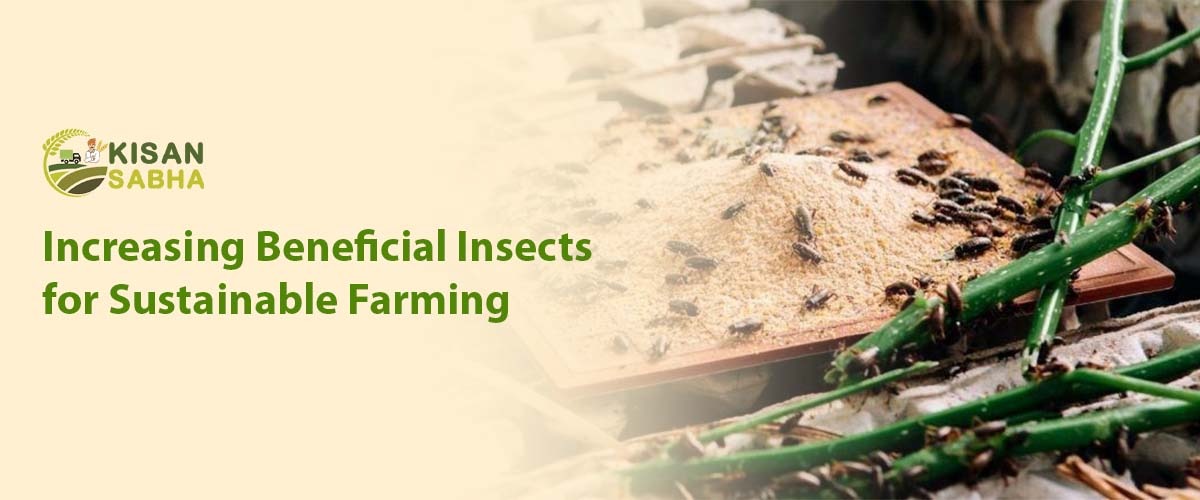As ecological concerns around industrial agriculture mount, farmers look to natural systems for inspiration. Beneficial predatory insects play vital roles in balancing ecosystems—functions we can leverage for integrated, ethical pest control and soil fertility on farms through habitat conservation. Beyond dramatically reducing dependence on toxic interventions, welcoming beneficial insect allies via selective plantings and structural landscapes boosts system resilience and crop quality for availing Sustainable Farming
The Role of Beneficial Insects:
There can be no question that useful insects are of great importance in sustaining integrated farming systems. These insects are in a sense the pesticide, they feed on the pests that affect farming by eating away crops. With these natural predators, farmers can be able to use a few synthetic pesticides, making Sustainable Farming more effectively
Ladybugs: Guardians of the Garden:
Lacewings and ladybugs are perhaps the most famous because of their ability to consume large numbers of aphids and other pests of soft-bodied insects. The use of ladybugs as a natural way of farming would eliminate the use of chemical substances on the crops on the farm. They may be useful as an effective means of pest control. While there lies a health benefit in these beautiful beetles, they are also biomarkers for health along with helping in Sustainable Farming.
Parasitoid Wasps: Nature’s Pest Control Agents
Powered by WPZY IMM Parasitoid wasps are also among the groups of insects that can be used to advance effective and sustainable agriculture. These wasps use their females to lay eggs into or on the host or even the body of the target which is mostly deadly pests. Organic pest management is an effective way of controlling pests. As it maintains a balance of the number of pests damaging the crops.
Ground Beetles: Guardians of the Soil
Ground beetles play a crucial role in supporting the ground’s or soil’s health. These arboreal or nocturnal animals prey on various subterraneous insects and farming pests like; cutworms and caterpillar larvae. Because ground beetles are active during the night, they help to control the population of pests. Consequently, organic fields do not require soil protection using chemical preparations.
Hoverflies: Male and Female Sterile Agents of Pollination and Pests
Hoverflies are not only pollinators but useful predators if considered in their immature stage and part of the fly. Hoverfly larvae are aphidvores that feed on pests like aphids, thrips, and others making it doubly beneficial to the farmers. The involvement of flowers which in turn, hoverflies helps in the pollination of crops while performing pest control.
Also Read:- A Complete Guide to Irrigation Systems in Agriculture
Synergizing Beneficial Insect Habitats
Permanent Polycultures:- Planting diverse, multi-story orchards, shrubbery, small trees, and perennial herbs provides year-round food and microclimates for all life stages. Key are native wildflowers like asters, clovers, goldenrods, yarrows, dandelions, and violets.
Cover Cropping:- Allowing leguminous nitrogen-fixing crops to bloom before mowing preserves forage and breeding habitat between cash crop rotations.
Beetle Banks:- Raised earthen banks along field edges featuring tussock grasses harbor alternative.
Water Sources:– Creating small wetlands, mud puddles, or dripping rocks quenches the thirst for water-dependent species and aids reproduction.
Reduced Disturbance:- Minimizing tillage and soil disruption protects delicate ground-nesting species. Leaving crop residue aids webbuilders like spiders.
Implementing Beneficial Insects in Farming Practices
To harness the full potential of beneficial insects, farmers can adopt several strategies:
Diverse Crop Rotation
Practical application of various crop rotations produces an environment favorable to the establishment of good insects. However, these outcomes call for crop diversification by farmers. It will increase the population of different predators that feed on the particular pests for attaining Sustainable Farming.
Conservation of Natural Habitats
The preservation of borders around or within the farming areas: hedgerows, wildflower strips, and other unmanaged areas are adapted to act as ‘insets hotels’. They also serve as conservation habitats because they keep natural predators sufficient to control pests and diseases.
Reduced Pesticide Usage
Reducing the application of broad-spectrum pest control agents is important to encourage the growth of pest insects. Also, this issue can be solved by applying stingless pesticides. These are applied only when they won’t affect useful insects, thus optimizing pest removal and the preservation of natural predators.
Conclusion
Pesticide integrated for pollination beneficial insects therefore becomes one of the ideal requirements for achieving sustainable farming. However, farmers can minimize their impact on the natural environment, decrease the use of synthetic inputs, and develop sustainable agricultural systems. While we go through the process of searching for new technologies that allow for environmentally friendly farming, the farmers’ cooperation with important insects is a vivid example of what can be achieved through Sustainable Farming.





